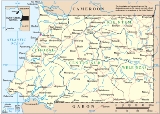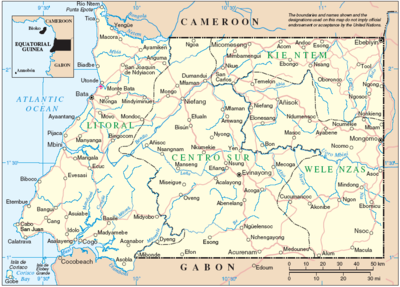
Río Muni
Encyclopedia

Equatorial Guinea
Equatorial Guinea, officially the Republic of Equatorial Guinea where the capital Malabo is situated.Annobón is the southernmost island of Equatorial Guinea and is situated just south of the equator. Bioko island is the northernmost point of Equatorial Guinea. Between the two islands and to the...
, and comprises the mainland geographical region, covering 26,017 km².
History
Río Muni was ceded by PortugalPortugal
Portugal , officially the Portuguese Republic is a country situated in southwestern Europe on the Iberian Peninsula. Portugal is the westernmost country of Europe, and is bordered by the Atlantic Ocean to the West and South and by Spain to the North and East. The Atlantic archipelagos of the...
to Spain
Spain
Spain , officially the Kingdom of Spain languages]] under the European Charter for Regional or Minority Languages. In each of these, Spain's official name is as follows:;;;;;;), is a country and member state of the European Union located in southwestern Europe on the Iberian Peninsula...
in 1778 in the Treaty of El Pardo
Treaty of El Pardo (1778)
The Treaty of El Pardo was signed on March 11, 1778 between Queen Maria I of Portugal and King Charles III of Spain. The treaty aimed at resolving long-standing territorial disputes arising from non-observance of the terms of the Treaty of Tordesillas and subsequent treaties to resolve the matter...
. The Spanish had hoped to collect slaves to work in their other overseas possessions, but their settlers died of yellow fever
Yellow fever
Yellow fever is an acute viral hemorrhagic disease. The virus is a 40 to 50 nm enveloped RNA virus with positive sense of the Flaviviridae family....
and the area was deserted. Cocoa and timber became major industries upon recolonization. Río Muni became a province of Spanish Guinea
Spanish Guinea
Spanish Guinea was an African colony of Spain that became the independent nation of Equatorial Guinea.-History:The Portuguese explorer, Fernão do Pó, seeking a route to India, is credited with having discovered the island of Bioko in 1472. He called it Formosa , but it quickly took on the name of...
along with Bioko
Bioko
Bioko is an island 32 km off the west coast of Africa, specifically Cameroon, in the Gulf of Guinea. It is the northernmost part of Equatorial Guinea with a population of 124,000 and an area of . It is volcanic with its highest peak the Pico Basile at .-Geography:Bioko has a total area of...
in 1959.
Population
Río Muni currently has a population of about 300,000, mainly composed of ethnic Fang tribes.Provinces
Rio Muni is composed of four provincesProvinces of Equatorial Guinea
||Equatorial Guinea is divided into 2 regions and seven provinces :-Regions:#Insular Region #Continental Region -Provinces:Provinces 1–3 in Insular Region; Provinces 4–7 in Continental Region....
:
- Centro Sur
- Kie-Ntem
- LitoralLitoral Province (Equatorial Guinea)Litoral Province is a province of Equatorial Guinea. Its capital is Bata the other two cities are Mbini and Kogo. The Littoral Province has the largest population of Equatorial Guinea....
- Wele-Nzas
Cities
The largest city is BataBata, Equatorial Guinea
Bata is a port city in the Litoral Province of Equatorial Guinea. With a 2005 estimated population of 173,046, it is the largest city in Equatorial Guinea. It lies on the Atlantic Ocean coast of Río Muni....
it is in the continental region of Rio Muni which also serves as the regional administrative capital. Other major towns include Evinayong
Evinayong
Evinayong is a town in south eastern Rio Muni, Equatorial Guinea, with a population of 7,997 as of 2001. It lies atop a small mountain and is known for its nightlife, its market and the nearby waterfalls....
, Ebebiyín
Ebebiyín
Ebebiyín is a town in the northeast of Rio Muni, Equatorial Guinea. It lies on the three-party border between Equatorial Guinea, Gabon and Cameroon. It is the end point of three main transport routes coming from Bata, Yaounde and major cities in central Gabon...
, Acalayong
Acalayong
Acalayong is a town across the Muni Estuary in the district of Kogo, Equatorial Guinea 117 km from Bata. It is one of the two border crossings, the other being Kogo from where passengers traveling to Gabon from Bata and the other cities, especially those from the Littoral province of...
, Acurenam
Acurenam
Acurenam is a town located on mainland Equatorial Guinea, in Centro Sur Province. Population 2,714...
, Mongomo
Mongomo
Mongomo is a city in Wele-Nzas Province in mainland Equatorial Guinea.From Mongomo originate the nation's first president Francisco Macías Nguema and of the current President Teodoro Obiang Nguema Mbasogo, hence the name the clan of Mongomo to define those belonging to his ruling clique.The area is...
, Sevilla de Niefang, Valladolid de los Bimbiles and Mbini
Mbini
Mbini is a town in Rio Muni, Equatorial Guinea, lying at the mouth of the Benito River. Mbini is the Ndowe name for Rio Muni. It is located 44km southwest of Bata....
.

